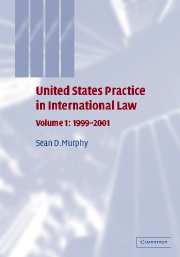Book contents
- Frontmatter
- Contents
- Foreword by Judge Thomas Buergenthal
- Acknowledgments
- Table of Periodical Abbreviations
- Table of Cases
- Table of U.S. Statutes
- Table of Treaties
- I General International and U.S. Foreign Relations Law
- II State Diplomatic and Consular Relations
- III State Jurisdiction and Immunities
- IV State Responsibility and Liability
- V International Organizations
- VI International Law and Nonstate Actors
- VII International Oceans, Environment, Health, and Aviation Law
- VIII International Economic Law
- IX International Human Rights
- X International Criminal Law
- XI Use of Force and Arms Control
- XII Settlement of Disputes
- XIII Private International Law
- Annex
- Index
XI - Use of Force and Arms Control
Published online by Cambridge University Press: 10 December 2009
- Frontmatter
- Contents
- Foreword by Judge Thomas Buergenthal
- Acknowledgments
- Table of Periodical Abbreviations
- Table of Cases
- Table of U.S. Statutes
- Table of Treaties
- I General International and U.S. Foreign Relations Law
- II State Diplomatic and Consular Relations
- III State Jurisdiction and Immunities
- IV State Responsibility and Liability
- V International Organizations
- VI International Law and Nonstate Actors
- VII International Oceans, Environment, Health, and Aviation Law
- VIII International Economic Law
- IX International Human Rights
- X International Criminal Law
- XI Use of Force and Arms Control
- XII Settlement of Disputes
- XIII Private International Law
- Annex
- Index
Summary
OVERVIEW
Each year, the president is required by law to submit to the Congress a comprehensive report on the national security strategy of the United States. Reviewing those reports provides a window on the attitude of the U.S. executive branch regarding how best to advance U.S. national security, including through the use of military force and arms control. Thus, in January 2000, the White House transmitted a report entitled “A National Security Strategy for a New Century” which asserted that there are three core objectives of U.S. national security. First, the United States seeks to enhance U.S. national security by “shaping the international environment” through diplomacy, foreign assistance, arms control, law enforcement cooperation, and environmental and health initiatives. The United States also endeavors to respond to threats and crises as they arise, whether in the form of threats to the U.S. territory, major theater warfare, or smaller scale contingencies. Second, the United States aims to promote prosperity through strengthening international financial coordination, enhancing energy security, and promoting open trade, sustainable development, and U.S. competitiveness. Third, the United States seeks to promote democracy, human rights, and respect for the rule of law. While the United States and other countries cannot respond to every humanitarian crisis, the report asserted that “when the world community has the power to stop genocide and ethnic cleansing, we will work with our allies and partners, and with the United Nations, to mobilize against such violence–as we did in Bosnia and Kosovo”–although the exact response will depend upon the capacity of countries to act, and on their perception of their national interests.
- Type
- Chapter
- Information
- United States Practice in International Law , pp. 387 - 460Publisher: Cambridge University PressPrint publication year: 2003



